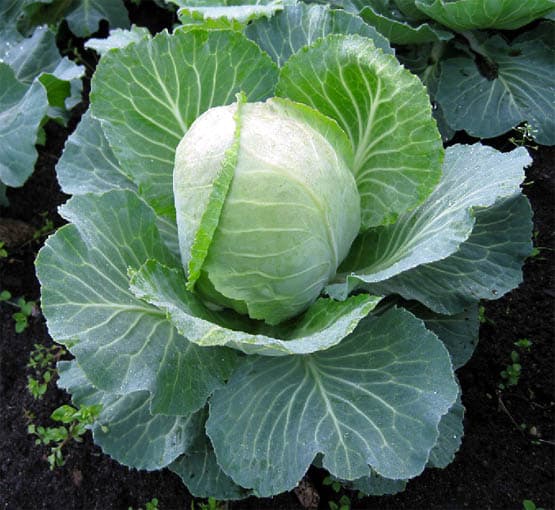Your shopping cart is empty!
White cabbage "Megaton" F1
Brassica oleracea L. convar. capitata (L.) Alef. var. alba DC.
1.61€
Ex Tax: 1.30€
Ex Tax: 1.30€
White Cabbage "Megaton" F1.
Sweet, crunchy, and juicy.
A very high-yielding mid-late hybrid, ideal for fermentation (sauerkraut).
The vegetation period is 100-105 days from transplanting seedlings. Grows very intensively, forming dense, very large heads weighing 8-10 kg.
This hybrid variety is resistant to Fusarium wilt, forming "heads" that are excellent for pickling and fermenting.
1.0 g = 250-300 seeds.

Cabbage for pickling.
Life cycle: white cabbage is a biennial plant grown as an annual crop.
Growing conditions: in open ground, under film shelters.
Seeds: white cabbage - 250-350 pcs per 1 g, cauliflower - 250-350 pcs per 1 g.
Sowing: 40-45 days before planting seedlings. For early production, sowing is carried out in heated glass or film greenhouses to a depth of 1-2 cm. When growing seedlings in cassettes, 1 seed is sown in each cell. When growing with pricking out, 1.5-2 g of seeds are sown per 1 m². Water after sowing. Before the first shoots appear, crops can be covered with film.
Germination: optimal temperature for seed germination is +18...+20°C. Shoots appear in 3-5 days. After the appearance of single shoots, the film is removed. After about 50% of seeds have sprouted, the temperature is lowered to +12..+15°C.
Seedling cultivation: prick out in the phase of developed cotyledons or when the first true leaf appears. Do not overwater the soil to prevent "black leg" (damping off). If necessary, carry out 1-2 feedings with complex fertilizers. 10-14 days before planting out, start hardening off the seedlings: increase ventilation, reduce watering, lower the temperature.
Planting out: seedlings are planted at the age of 35-40 days. Before spring soil cultivation, fertilizer is applied at the rate of 2-2.5 kg N, 0.75-0.8 kg P2O5, 2.5-3.0 kg K2O per 100 m² (cauliflower requires slightly less nitrogen and more potassium). When planting cauliflower, boron and molybdenum are also added. Avoid using fertilizers containing chlorine. Planting scheme for early white cabbage - 50x30-40 cm, early cauliflower - 70x40-50 cm. Before planting, water the holes abundantly.
Soil: well-drained, fertile, loamy (for cauliflower, necessarily rich in humus and nutrients in accessible form), pH 6-7, water-holding.
Temperature: cabbage is a cold-resistant plant. Well-hardened seedlings after planting in the field withstand short-term frosts down to -2...-5°C. During the growing season, the optimal temperature is +15...+18°C.
Watering: keep the soil moist. With low soil and air humidity, plants develop poorly. Optimal soil moisture 75-80%, relative air humidity 85-90%. If necessary, watering is carried out every 6-8 days. At the end of the growing season, watering is undesirable to avoid cracking of heads.
Nutrition: to obtain high yields, plants are fed 2-3 times after planting.
Maturation: early varieties and hybrids are ready for harvest 50-60 days after planting seedlings
Sweet, crunchy, and juicy.
A very high-yielding mid-late hybrid, ideal for fermentation (sauerkraut).
The vegetation period is 100-105 days from transplanting seedlings. Grows very intensively, forming dense, very large heads weighing 8-10 kg.
This hybrid variety is resistant to Fusarium wilt, forming "heads" that are excellent for pickling and fermenting.
1.0 g = 250-300 seeds.

Cabbage for pickling.
Life cycle: white cabbage is a biennial plant grown as an annual crop.
Growing conditions: in open ground, under film shelters.
Seeds: white cabbage - 250-350 pcs per 1 g, cauliflower - 250-350 pcs per 1 g.
Sowing: 40-45 days before planting seedlings. For early production, sowing is carried out in heated glass or film greenhouses to a depth of 1-2 cm. When growing seedlings in cassettes, 1 seed is sown in each cell. When growing with pricking out, 1.5-2 g of seeds are sown per 1 m². Water after sowing. Before the first shoots appear, crops can be covered with film.
Germination: optimal temperature for seed germination is +18...+20°C. Shoots appear in 3-5 days. After the appearance of single shoots, the film is removed. After about 50% of seeds have sprouted, the temperature is lowered to +12..+15°C.
Seedling cultivation: prick out in the phase of developed cotyledons or when the first true leaf appears. Do not overwater the soil to prevent "black leg" (damping off). If necessary, carry out 1-2 feedings with complex fertilizers. 10-14 days before planting out, start hardening off the seedlings: increase ventilation, reduce watering, lower the temperature.
Planting out: seedlings are planted at the age of 35-40 days. Before spring soil cultivation, fertilizer is applied at the rate of 2-2.5 kg N, 0.75-0.8 kg P2O5, 2.5-3.0 kg K2O per 100 m² (cauliflower requires slightly less nitrogen and more potassium). When planting cauliflower, boron and molybdenum are also added. Avoid using fertilizers containing chlorine. Planting scheme for early white cabbage - 50x30-40 cm, early cauliflower - 70x40-50 cm. Before planting, water the holes abundantly.
Soil: well-drained, fertile, loamy (for cauliflower, necessarily rich in humus and nutrients in accessible form), pH 6-7, water-holding.
Temperature: cabbage is a cold-resistant plant. Well-hardened seedlings after planting in the field withstand short-term frosts down to -2...-5°C. During the growing season, the optimal temperature is +15...+18°C.
Watering: keep the soil moist. With low soil and air humidity, plants develop poorly. Optimal soil moisture 75-80%, relative air humidity 85-90%. If necessary, watering is carried out every 6-8 days. At the end of the growing season, watering is undesirable to avoid cracking of heads.
Nutrition: to obtain high yields, plants are fed 2-3 times after planting.
Maturation: early varieties and hybrids are ready for harvest 50-60 days after planting seedlings
Did you know... the easiest and fastest way to ferment cabbage: clean the heads, cut into pieces, put in an enamel pot and pour boiling brine (1 tablespoon of salt per 1 liter of water); cover with a lid so that the cabbage does not float.
When the brine cools, add a crust of rye bread and put the pot in a warm place for 2-3 days. The result is tender salad sauerkraut.
You can add beets or dried mint leaves. Late cabbage varieties are especially good for fermentation.












